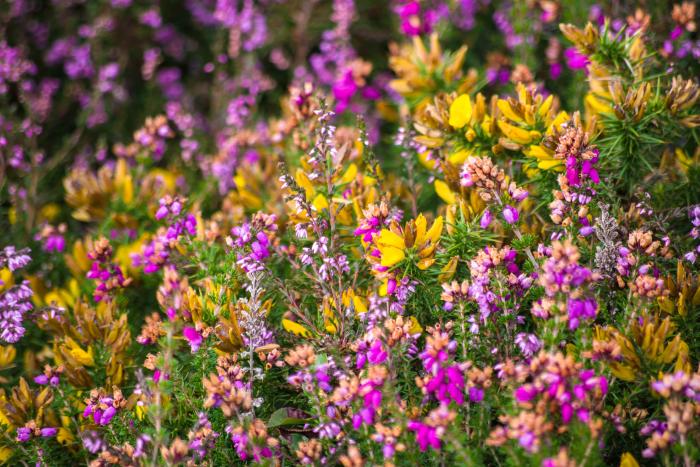
Gorse flowers year round but is at its most abundant in April, its delicate coconut fragrance is an unlikely pairing with its rigid, prickly spines. The dense structure it provides is a refuge for birds in harsh weather, essential for the survival of Dartford warblers in winter.
It's a crucial nectar source during the colder months and really important for invertebrates - it's the food plant for the caterpillars of over 55 moths and butterflies, making it a larder for insect-eating birds like our ‘Darties’. Cleverly adapted to survive the low nutrient soils of heathland, gorse hosts a special bacteria in its root nodules that secures nitrogen from the air present within soil. Remarkable!
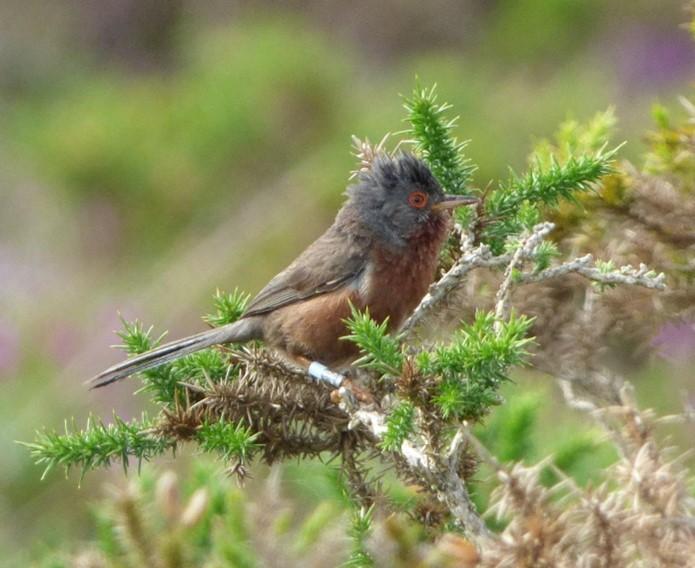
Dartford warblers can be seen all year round on the Pebblebeds, though are shy and elusive outside of the breeding season (March to September). At this, the northernmost extent of their range, the population is vulnerable to prolonged spells of cold weather.
They often share singing perches and territories with companion stonechat, both nesting close to the ground, deep in heather and gorse. The two can often be seen together, with stonechat more brazen than his shyer associate, perching on gorse tips above as ‘Darty’ dives beneath, safe under cover.
Dartford warblers are short lived birds, with typically lifespans of only a couple of years. They breed after the first year, producing on average, 2 broods of 4 eggs each breeding season (March-September). Eggs are incubated for 14 days, with juveniles fledging after another 14.
Nests are built in low scrub typical of the heathland landscape. This leaves them vulnerable to disturbance if we or our dogs stray from the paths. Stick to the main tracks to help these quirky little birds thrive.
Dartford warblers have a strict insectivorous diet; heather and gorse are great insect larders, full of tasty mites and spiders.
Their song is a scratchy mechanical sound, listen here for a tweet of the day.
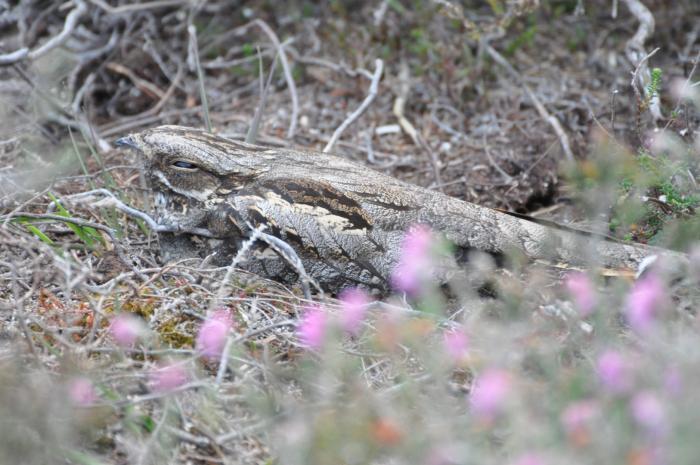
Nightjar. Our fascination with the nightjar goes back generations, with many references in folk law and poetry.
Its latin name, Caprimulgus, translates as ‘goatsucker’, deriving from an ancient myth that these birds suckled milk from goats. The superstitious blamed nightjar for milk running dry and even livestock blindness. Luckily, we now realise their sightings near livestock were purely because of the associated insects - nightjar are "crepuscular", feeding at dawn and dusk on moths and beetles in flight.
Their song is a mechanical churr and can be heard echoing around the quiet heath at dawn and dusk. Nightjars fly over 4000 miles all the way from Sub-Saharan Africa to breed on our heaths from May to September. What a feat of endurance!
Like so many strange creatures, they lie low in daylight, and are camouflaged to blend in to dry heathland scrub. They do not nest in trees – in fact they barely ‘nest’ at all - their similarly cryptic eggs are laid in a shallow scrape on the ground.
Because Nightjar are ground nesters, they are incredibly sensitive to disturbance by us and our dogs. If flushed off their 'nest' then predators can be alerted to the location and will feed on the eggs. Please stick to main paths and keep your dog in sight and on the path during bird breeding season (March-September).
Want to see and hear them for yourself? That’s great! There are often guided nightjar walks taking place across the Pebblebed Heaths during May and June. See Wild East Devon listings for more info.
Southern Damselfly (photo credit Charles J. Sharp)
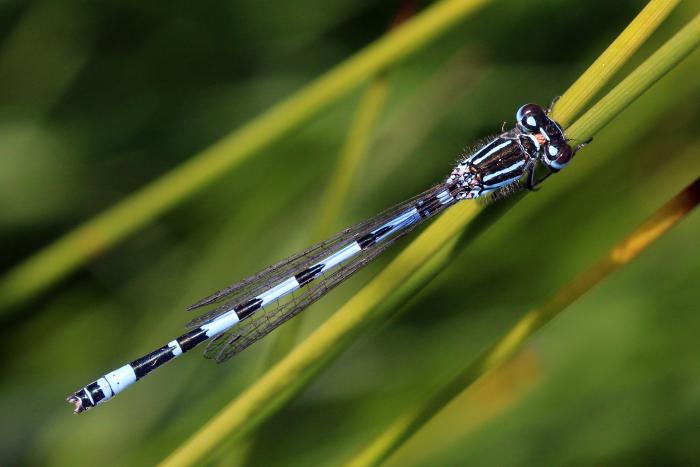
The East Devon Pebblebed Heaths support some of the last populations of Southern Damselfly in England.
Red listed as one of Europe’s rarest and most threatened damselflies and defined as a globally threatened species this is one of the heaths rarest species.
Up to 25% of the world population are located in southern England and Wales, where it is at the northern extent of its range.
Preferred habitat are the small water channels, or ‘runnels’, found in the mires of Aylesbeare, Venn Ottery and Colaton Raleigh Commons. Highly specialised, they need conditions to be just right in order to thrive. Those created by grazing cattle and ponies seem to be beneficial – maintaining the open nature of runnels and keeping vegetation in check enables the damselfly to complete all the stages of its lifecycle, most of which it spends as larvae in the water rather than flying as an adult. Southern damselfly are delicate flyers, rarely straying far from breeding sites. It is unlikely the pocket populations of the Pebblebeds are able to interact.
Adults fly from June to August and can be tricky to identify in comparison to other species of blue damselfly, some useful tips can be found here: Southern Damselfly - British Dragonfly Society (british-dragonflies.org.uk)
Special mention to super-volunteer Lesley Kerry, who has monitored these damselflies and their lowland heath habitat for many years.
Heathers (photo credit Malcolm Jarvis)
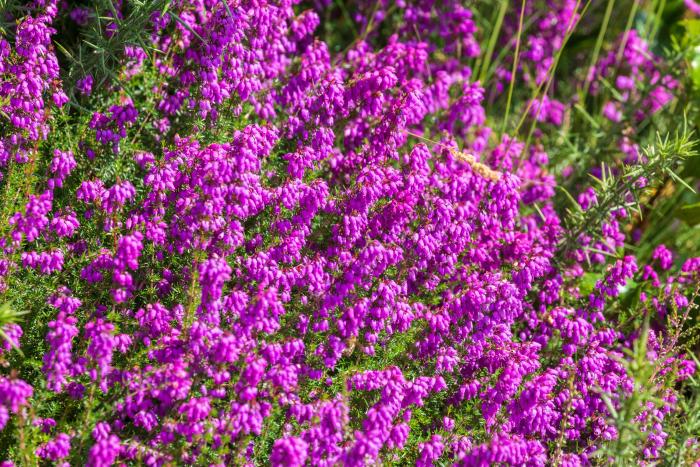
Heather species flower later in the year and are at their best in August, turning this green space a glowing purple. The heath comes alive with the buzz of pollinators. The slow growing nature of heather allows it to grow in acidic, nutrient poor conditions, with these plants living for up to 45 years.
Only specialised plants, adapted to poor heathland soils flourish, with some resorting to intriguing means to find nutrients. The leaves of carnivorous Sundew have glandular tentacles covered with sticky dew-like droplets. These catch unwary insects and curl inwards, trapping the insect while they ooze digestive enzymes to slowly absorb the nutrients released. Gruesome!
Pretty, pink Lousewort takes an alternative strategy, and parasitizes the roots of other plants to gain the nutrients it needs to survive.